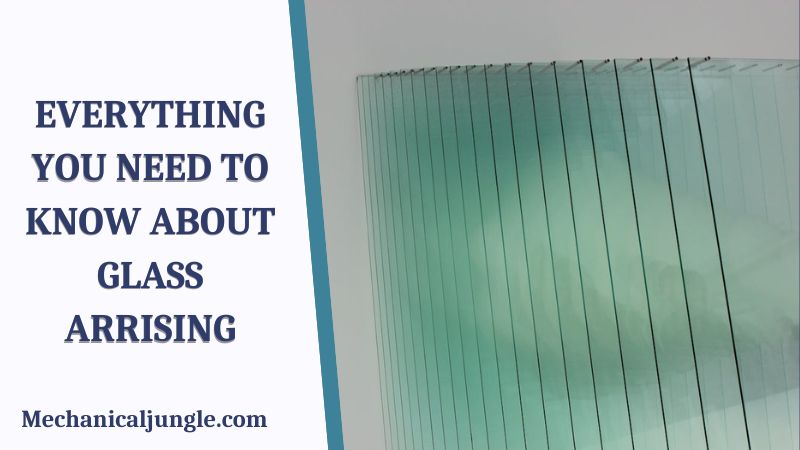Important Point
Everything You Need to Know About Glass Arrising
For over 4,000 years, glass has become an essential component in construction. Churches, commercial buildings, and residences are adorned with it to provide comfort, security, and visual appeal. Solar panels, automobiles, and a long list of products also require quality glass.
We owe it all to the glass production process which has come a long way. With the development of new methods, better options are made available to builders and consumers. However, one thing that remains essential to the glass production process is arrising. Here, we are going to talk about glass arrising and how it’s done.
Also, Read: How to Fix a Leaking Car Roof | Why Water Leaks into Car from its Roof? | Why Is Water Leaking into My Car?
What Is Glass Arrising?
Glass manufacturing undergoes a number of steps, starting with merging and melting raw materials and molding them into desired shapes. The last step involves smoothing out jagged and sharp edges to make the products easier to handle, transport, and install.
The process of getting rid of imperfect edges is called arrising and it’s done for multiple reasons. The first is to ensure safety. Raw edges can cause injuries when they are not smoothened out. There is also the need to make sure the glass fits a client’s aesthetic and functional needs. Arrising allows for a clean and professional-looking final output which is crucial for architectural purposes.
Another critical reason to do glass arrising is to reinforce the surface and make the installation process easier. Imprecise edges may compromise the durability of the final product. This will lead to a short lifespan and increased costs. Glass arrising is a process that must not be overlooked. Without it, builders and developers might not accomplish their design goals and pay more.
Considering the number of steps that are involved, it matters to use the latest technologies in making sure that the final product is safe without incurring additional costs throughout the process. That is why manufacturers invest in quality arrising equipment such as CNC machines to ensure that their products are up to standards.
How is Glass Arrising Done?
The first is to cut out the glass so it matches a certain shape. Then, the surface must be cleared of residue before the glass cut-out is grounded at the edges. A number of machines are used during this phase. Some manufacturers make use of processing machines such as the CombiFIN vertical line that already comes with a grinding component along with a grinding and milling feature.
After the grinding process, the glass goes through beveling and chamfering depending on the client’s requirements. Beveling helps angle the edges to create a sloping effect. On the other hand, chamfering is used to smoothen out a 90-degree edge to create an aesthetically pleasing final product.
At the end of this process, the glass undergoes final polishing using special tools and adhesives. This eliminates scratches on the surfaces that may have been caused during manufacturing. Polishing also ensures that the glass is clear of imperfections and, for certain products, improves transparency or reflectability. The products are then stored and subjected to final inspection before being shipped out.
The glass manufacturing industry is essential to the larger construction sector. Not only that, but it also provides materials for other sectors, such as automotives and aerospace exploration. Ensuring that glass products are safe to handle and fit functional requirements won’t be possible without arrising.
Also, Read: Head Gasket | What Is the Best Head Gasket Sealer to Use? | What Can Cause a Head Gasket to Blow?
Frequently Asked Questions (FAQ)
What Is Glass Arrising?
This type of edging involves flat grinding glass edges until they are smooth and then running the top and bottom edges along a belt to eliminate sharpness and remove chips.
How is Glass Arrising Done?
Glass arrising process can be done with maximum cycle and speed automatically. Special belts breaks the back and front side of the glass sheets and arrise the glass. The head can rotate freely in 360° in order to arrise all sides of the glass sheets.
Like this post? Share it with your friends!
Suggested Read –
- Solar Panel Parts
- Difference Between Orthogonal and Oblique Cutting | Orthogonal Machining
- Parts of Shaper Machine | What Is the Shaper Machine? | Working of Shaper Machine
- What Is a Synchromesh Gearbox? | Principle of Synchromesh Gearbox | Construction of Synchromesh Gearbox | Working of Synchromesh Gearbox
- Working of Constant Mesh Gearbox | What Is a Constant Mesh Gearbox? | Different Gear Ratios in Constant Mesh Gearbox | Construction of Constant Mesh Gearbox
- What Is Magneto Ignition System | How Does an Ignition System Work | How Does a Magneto Work | What Does a Magneto Do | Magneto Ignition System


Leave a Reply